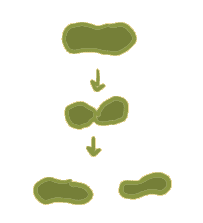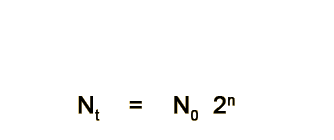 Build the basic growth equation
Build the basic growth equation
As you know, bacteria multiply by dividing, so to speak. A single bacterium grows and then divides into 2. Those two "daughter" cells eventually divide in 2. And so on and so on.
The formula for exponential growth should be familiar to you. Starting with one cell dividing in half, the resulting numbers would look like this:
Initial number --> 1
Number after 1 doubling --> 1×2
Number after 2 doublings --> 1×2×2
Number after 3 doublings --> 1×2×2×2
Number after 4 doublings --> 1×2×2×2×2
Given the algorithms above, which of the following is the correct equation for calculating the number of cells (N) after three doublings (also called generations) starting from a single cell? In these equations, ‘n’ represents the number of doublings.
| N = n | N = 1 | N = 1 | N = 1 |
|---|---|---|---|
With a few more changes, we can make this look more formal.
- Matt is likely to have consumed a large number of Vibrio, and more than one is likely to have found its way to his intestine. So, instead of the initial population being 1, let's call it N0 , meaning "the number of cells in generation 0". (This is also really important when we're talking about bacteria in the lab, because the starting numbers are usually much higher).
- Less importantly, in the equation below, I removed the multiplication sign - it's still there, just invisible.
Our final equation looks like this:
Copyright University of Maryland, 2007
You may link to this site for educational purposes.
Please do not copy without permission
requests/questions/feedback email: mathbench@umd.edu
